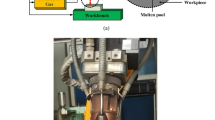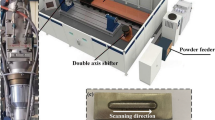Abstract
Laser cladding technology has been widely applied in industrial production because of its prominent advantage in surface modification. To achieve improved microstructure characteristics and performance, it is essential to investigate the solidification mechanism of the microstructures formed during laser cladding. In this study, the columnar-to-equiaxed transition for laser-clad 316L was predicted using a three-dimensional finite element model coupled with electron backscatter diffraction analysis. First, the distribution of thermodynamic variables at different laser powers was examined. Then, the fitting curve for predicting the columnar-to-equiaxed transition was established, and the results indicate that the solidification of laser-clad 316L can be accurately predicted. Moreover, the grain size distribution for different laser powers was counted, and the average grain size of the molten pool was shown to increase with increasing laser power. This work will serve as a guide for the crystal transition in the solidification process for laser cladding.
Similar content being viewed by others
References
Zhao W, Zha GC, Xi MZ, Gao SY (2018) Effects of synchronous rolling on microstructure, hardness, and wear resistance of laser multilayer cladding. Int J Adv Manuf Technol 27:1746–1752
Liu HM, Hu ZQ, Qin XP, Wang YL, Zhang J, Huang S (2017) Parameter optimization and experimental study of the sprocket repairing using laser cladding. Int J Adv Manuf Technol 91:3967–3975
Zhao Y, Yu YB, Sun JY, Xi WC, Bi XX (2018) Effect of laser cladding on forming qualities of YCF101 alloy powder in the different lap joint modes. Int J Adv Manuf Technol 96:1991–2001
Wang C, Gao Y, Wang R, Wei D, Cai M, Fu Y (2018) Microstructure of laser-clad Ni60 cladding layers added with different amounts of rare-earth oxides on 6063 Al alloys. J Alloys Compd 740:1099–1107
Sun S, Fu H, Ping X, Lin J, Lei Y, Wu W (2018) Reinforcing behavior and microstructure evolution of NbC in laser cladded Ni45 coating. Appl Surf Sci 455:160–170
Zhou SF, Xu YB, Liao BQ, Sun YJ, Dai XQ (2018) Effect of laser remelting on microstructure and properties of WC reinforced Fe-based amorphous composite coatings by laser cladding. Opt Laser Technol 103:8–16
Adesina OS, Popoola API, Pityana SL, Oloruntoba DT (2018) Microstructural and tribological behavior of in situ synthesized Ti/Co coatings on Ti-6Al-4V alloy using laser surface cladding technique. Int J Adv Manuf Technol 95:1265–1280
Jiao XY, Wang J, Wang CM, Gong ZQ, Pang XX, Xiong SM (2018) Effect of laser scanning speed on microstructure and wear properties of T15M cladding coating fabricated by laser cladding technology. Opt Lasers Eng 110:163–171
Masanta M, Shariff SM, Choudhury AR (2011) Evaluation of modulus of elasticity, nano-hardness and fracture toughness of TiB2-TiC-Al2O3 composite coating developed by SHS and laser cladding. Mater Sci Eng A 528(16–17):5327–5335
Casati R, Lemke JN, Vedani M (2016) Microstructure and fracture behavior of 316L austenitic stainless steel produced by selective laser melting. J Mater Sci Technol 32(8):738–744
Song J, Chew YX, Bi GJ, Yao XL, Zhang BC (2018) Numerical and experimental study of laser aided additive manufacturing for melt-pool profile and grain orientation analysis. Mater Design 137:286–297
Yang JJ, Yu HC, Yang HH, Li FZ, Wang ZM, Zeng XY (2018) Prediction of microstructure in selective laser melted Ti-6Al-4V alloy by cellular automaton. J Alloys Compd 748:281–290
Liu J, To AC (2017) Quantitative texture prediction of epitaxial columnar grains in additive manufacturing using selective laser melting. Addit Manuf 16:58–64
Botello OL, Hernandez UM, Ramírez J, Pinna C, Mumtaz K (2017) Two-dimensional simulation of grain structure growth within selective laser melted AA-2024. Mater Design 113:369–376
Liu SW, Zhu HH, Peng GY, Yin J, Zeng XY (2018) Microstructure prediction of selective laser melting AlSi10Mg using finite element analysis. Mater Design 142:319–328
Sabbaghzadeh J, Azizi M, Torkamany MJ (2008) Numerical and experimental investigation of seam welding with a pulsed laser. Opt Laser Technol 40(2):289–296
Liu S, Kong F, Shi SH (2014) Study of a hollow laser beam for cladding. Int J Adv Manuf Technol 73:147–159
Hadadzadeh A, Amirkhiz BS, Li J, Mohammadi M (2018) Columnar to equiaxed transition during direct metal laser sintering of AlSi10Mg alloy: effect of building direction. Addit Manuf 23:121–131
Dong LG, Peng QJ, Han EH, Ke W, Wang L (2018) Microstructure and intergranular stress corrosion cracking susceptibility of a SA508-52M-316L dissimilar metal weld joint in primary water. J Mater Sci Technol 34(8):1281–1292
Zhang Z, Farahmand P, Kovacevic R (2016) Laser cladding of 420 stainless steel with molybdenum on mild steel A36 by a high power direct diode laser. Mater Design 109:686–699
Carter LN, Martin C, Withers PJ, Attallah MM (2014) The influence of the laser scan strategy on grain structure and cracking behaviour in SLM powder-bed fabricated nickel superalloy. J Alloys Compd 615(2):338–347
Funding
The present study was supported by the National Natural Science Foundation of China (Grant No. 51504198), the National Science Foundation of China (Grant No. 51474178), and the Fundamental Research Funds for the Central Universities (Grant No. A0920502051820-48).
Author information
Authors and Affiliations
Corresponding author
Ethics declarations
Conflict of interest
The authors declare that they have no conflict of interest.
Additional information
Publisher’s note
Springer Nature remains neutral with regard to jurisdictional claims in published maps and institutional affiliations.
Rights and permissions
About this article
Cite this article
Ma, P., Wu, Y., Zhang, P. et al. Solidification prediction of laser cladding 316L by the finite element simulation. Int J Adv Manuf Technol 103, 957–969 (2019). https://doi.org/10.1007/s00170-019-03566-9
Received:
Accepted:
Published:
Issue Date:
DOI: https://doi.org/10.1007/s00170-019-03566-9




